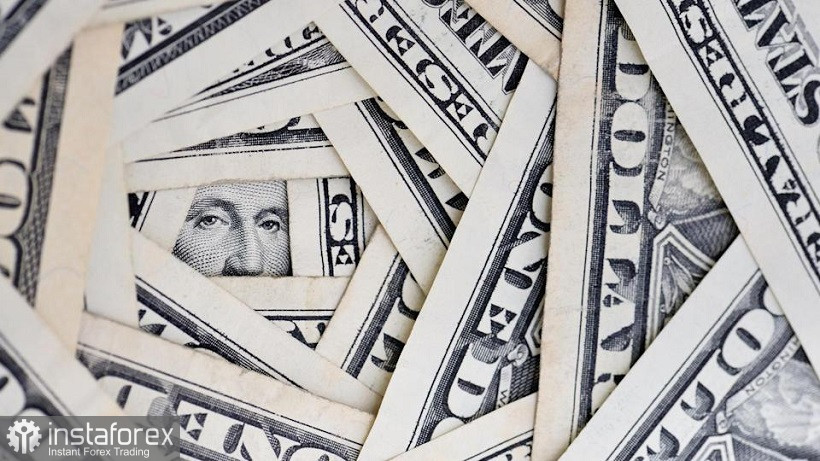The euro-dollar pair updated the monthly price low on Friday, reaching 1.0837. Bears have approached the annual low (1.0805), which was updated exactly a month ago – on March 7. And although at the end of Friday's trading, bulls regained some of the lost positions, ending the trading week at 1.0877, the fact remains that bearish sentiment still dominates the pair. And next week will be in some sense indicative. Either bears will storm the 1.0800 mark, opening their way to the area of the 7th figure, or bulls will be able to return the pair to the range of 1.0900-1.1000. "Technique" categorically speaks about the priority of the downward scenario. But with the "foundation" everything is not so clear, although in general the information flow signals that the pair will be under significant pressure. Especially if the elections in France presents an unpleasant surprise to the current president of the country, Emmanuel Macron.

But let's talk about everything in order. The geopolitical background remains quite gloomy, which, however, reflects very well on the dollar's positions. The Russian–Ukrainian negotiation process and Taiwan are on the agenda. As for the negotiations between Moscow and Kiev, there is no progress here – at least in the public plane, a kind of information vacuum has formed here. Obviously, there was no breakthrough in the negotiations. According to media reports, the parties continue to contact via video link, but there are no prerequisites for a face-to-face meeting where the agreements reached could be recorded. At the same time, the messages voiced are quite pessimistic in nature. For example, this week, Russian Foreign Minister Sergei Lavrov said that Kiev "departed from some of the agreements that were reached between the delegations at the talks in Istanbul." In turn, the representative of the Turkish president said that he does not expect a serious breakthrough in the negotiations between Moscow and Kiev "in the next couple of days or even weeks." The main reason is the lack of consensus between Russia and Ukraine "on some points of negotiations."
In other words, the negotiation process continues, but it is clearly stalling. The information vacuum in this case plays on the side of the greenback, which is in high demand due to the growth of anti-risk sentiment in the market.
The "Taiwan case" also adds fuel to the fire. The statements of Chinese politicians and officials (especially the military) are getting tougher, against the background of increased supplies of American weapons to the island. In particular, this week, the official representative of the Ministry of Defense of the People's Republic of China Tan Kefei said that the Chinese army "will take effective measures to prevent external interference and attempts to achieve Taiwan's independence." Such statements, and the current situation in general, provide indirect support to the safe dollar – again, due to the growth of anti-risk sentiment.
The Federal Reserve also supports the greenback. Last week, the Fed's minutes were published, according to which the central bank is ready to raise the interest rate by 50 points "at one or more meetings." In addition, during their speeches, many members of the Fed either did not rule out such a scenario, or supported it, at least in the context of the May meeting. It should be added here that in March, fairly strong data were published in the US labor market and inflation. All these factors serve as a reliable support for the dollar.
The European currency, in turn, is under significant pressure. The European Central Bank's passive position, the risk of stagflation and the impending energy crisis due to the sanctions standoff – all these fundamental factors play against the euro. The "cherry on the cake" was the French presidential election. The fact is that Marine Le Pen is "breathing down the back of Emmanuel Macron's neck" there – and this fact clearly worries European investors. The first round of elections will be held on April 10, and with a high probability, it will not end with one round. In two weeks (April 24), Macron and Le Pen will meet in the second round. And if earlier Macron was ahead of his rival with a score of 56/44 without any problems, but then the situation began to change 58/42 and 52/48. The most recent polls show almost equality. For example, a poll published on Thursday showed that the incumbent president has an advantage of only 6 percentage points. According to many political scientists, entering the elections with a falling rating is a very bad sign. Therefore, traders face two weeks of anxious waiting. This fact will undoubtedly have a negative impact on the positions of the euro. It should be noted that today Le Pen is no longer in favor of abandoning the euro and France's withdrawal from the EU, as it was in 2017, during the previous presidential campaign. However, Eurosceptic sentiments still "slip" in her rhetoric and program. In particular, she wants to turn the European Union into a Union of Nations not bound by the common laws of the European Union. In any case, Macron's unconvincing victory in the first round will be another problem for the euro.
All this suggests that short positions on the EUR/USD pair are still relevant. The same thing is said by the "technique": on the D1 timeframe, the pair is located under all the lines of the Ichimoku indicator, which shows a bearish Parade of Lines signal. On Friday, the pair tested an important support level of 1.0850, which corresponds to the lower line of the Bollinger Bands indicator. If bears push this target next week, then the next level of support will be the psychologically important mark of 1.0805 (the annual price low).
 English
English 
 Русский
Русский Bahasa Indonesia
Bahasa Indonesia Bahasa Malay
Bahasa Malay ไทย
ไทย Español
Español Deutsch
Deutsch Български
Български Français
Français Tiếng Việt
Tiếng Việt 中文
中文 বাংলা
বাংলা हिन्दी
हिन्दी Čeština
Čeština Українська
Українська Română
Română

